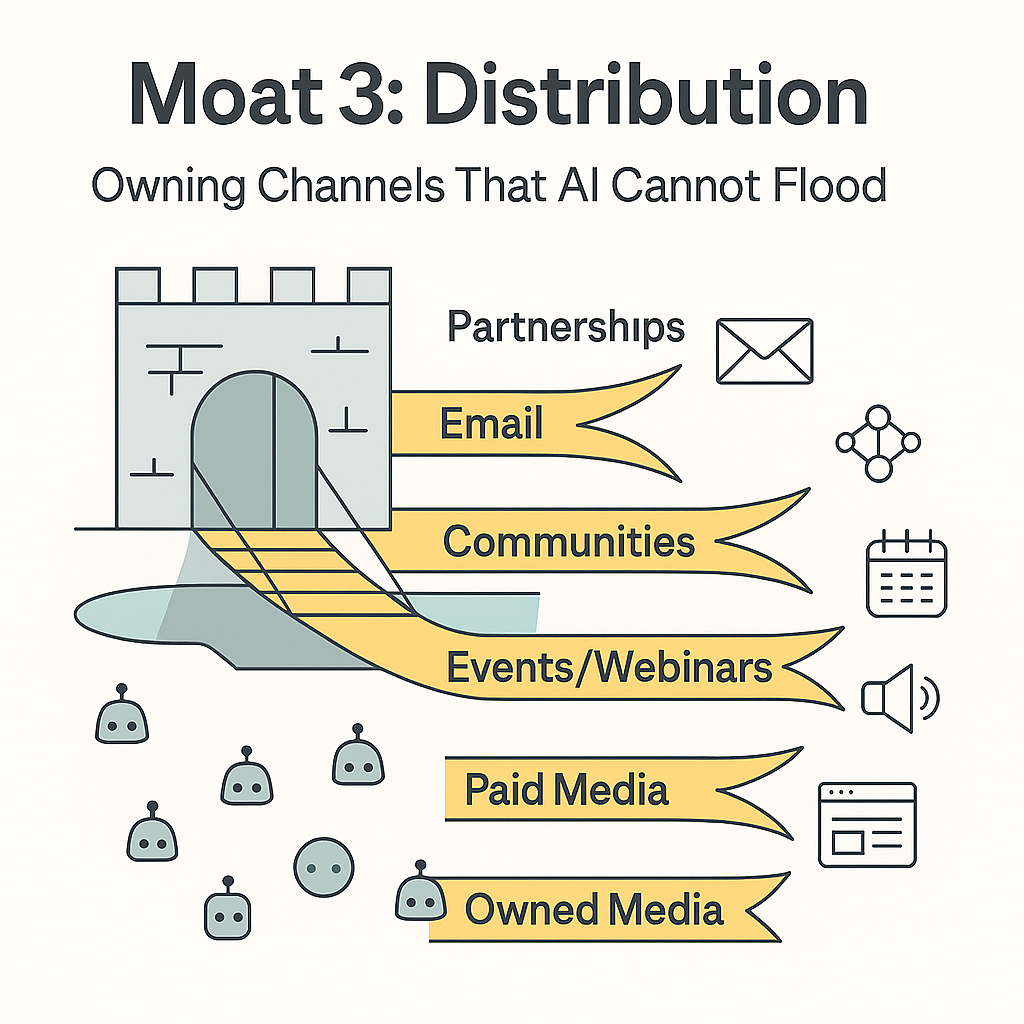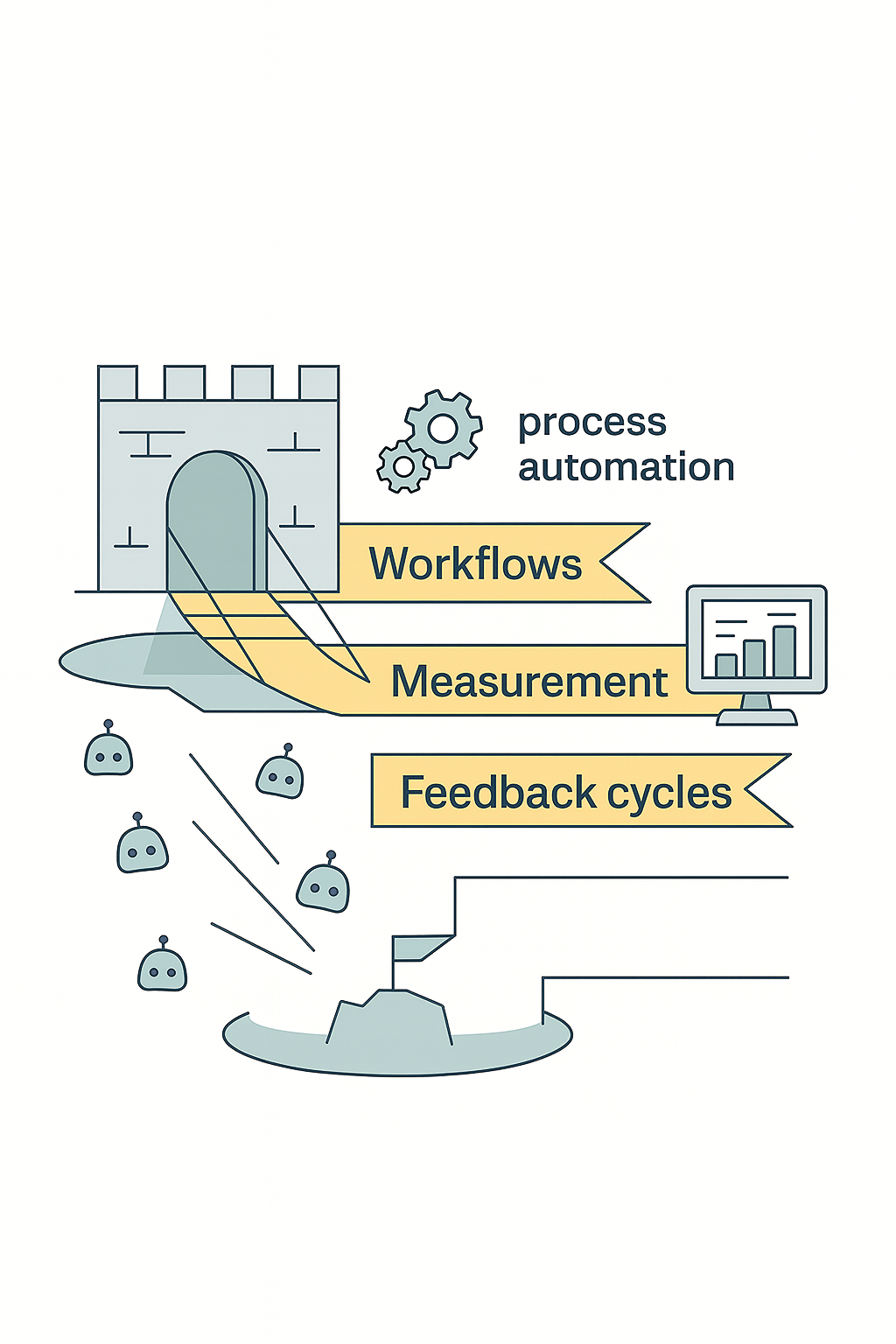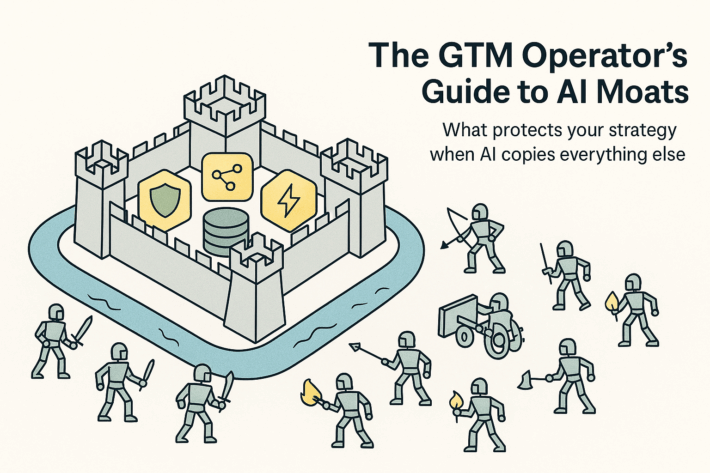How Distribution Becomes a GTM Moat in the Age of AI

Why Controlling Your Own Channels Matters More Than Ever
This is Part 3 of the AI Moats series. If you missed earlier sections, start with
For years distribution looked like an arms race. Companies with the deepest pockets could dominate ads, buy giant prospect lists, or put on the loudest trade show booths. That kind of spend was enough to look like the category leader. The equation broke once AI dropped the cost of flooding every channel. Outreach tools now churn out endless sequences, content engines spin up articles that read clean enough for search engines to index, and feeds are flooded with repetition. Buyers open inboxes filled with the same subject lines or scroll feeds clogged with copycat takes, and their reflex is to ignore.
The teams still breaking through are the ones who control their own lanes. Distribution that holds in 2026 means you’ve built or earned direct paths to buyers where AI noise can’t drown you out.
Email works when the list is curated and alive. Blasting generic sequences doesn’t create an advantage — it creates fatigue. The moat comes when every contact on your list knows your voice, expects relevance, and opens because the sender matters.
Morning Brew scaled from a college side project to over 4 million readers by turning their email into a daily habit. The format wasn’t the secret. Many competitors tried the same. What stuck was the consistent voice and predictable value that made opening the email a reflex.
For SaaS, the lesson is segmentation. The CIO evaluating integrations should never receive the same nurture as the practitioner testing features. Each message has to show it’s worth the time. AI can flood inboxes, but it cannot recreate a trusted relationship that took years to build.
Partnerships
Partnerships extend distribution through ecosystems where competitors can’t simply walk in. A well-placed integration or co-marketing agreement plugs you into reach that money alone can’t buy.
Salesforce AppExchange is proof of how powerful that can be. Vendors who win placement on AppExchange don’t rely on ads to reach Salesforce customers. They inherit exposure to a base that already trusts the platform. A rival tool can code a similar feature, but displacing a proven integration isn’t fast or easy.
The same applies to SaaS marketplaces, cloud partner programs, or vertical resellers. If your product is part of another company’s go-to-market playbook, you’ve created distribution that’s sticky by design.
Communities
Communities become a moat when people rely on them for answers and connection. It’s more than a place to push announcements — it’s a space people don’t want to lose.
HubSpot’s user community is an example. Their forums and groups connect thousands of marketers troubleshooting campaigns and sharing workarounds. Competitors can launch their own communities, but they can’t recreate years of accumulated questions, answers, and member trust.
Communities take real investment. They need moderation, fresh prompts, and visible leaders. Without that, engagement dies. But when they’re alive, they hold attention in ways ads never can.
Events and Webinars
Events create distribution that AI can’t counterfeit. When people block an hour to hear from you, they’re investing attention in a way no feed post can achieve.
SaaStr Annual shows what happens when events build rhythm. The conference gathers thousands of SaaS leaders every year, and the density of operators in one place generates conversations, partnerships, and deals. It isn’t just content, it’s a habit the industry relies on.
For startups, even smaller recurring webinars can build the same pattern. What matters is consistency and quality of insight. Once buyers expect your events, they become part of your channel mix.
Paid Media
Paid channels don’t create moats on their own. Anyone can spend. The advantage comes from how you target. When ads are fueled by your own usage data or customer signals, you get leverage.
The LinkedIn B2B Institute has shared recent studies showing how precision targeting delivers outsized returns compared to broad campaigns. The insight is clear: if you use the same generic lookalike audiences as everyone else, you burn cash. If you use data nobody else has, your spend becomes harder to compete with.
Owned Media
Owned channels are insurance against platform shifts. If LinkedIn’s algorithm changes or Google throttles your reach, an email newsletter, blog, or podcast you control still gets through.
Stripe’s Increment used to be the go-to example, but that publication stalled after 2021, which makes it a poor reference today. A better example in 2025 is HashiCorp’s blog, which publishes regular technical content that developers return to. Those posts are sticky because they solve real problems, not because of distribution hacks.
Owned media is slow to build, but when buyers know where to find you, it gives you reach that nobody else can switch off.
Where companies fail
They over-rely on channels they don’t control. They dump budget into ads and treat it as permanent reach. They buy lists instead of earning them, training buyers to ignore. They launch partnerships with no depth, making it easy to be replaced. They set up communities, but without moderation and care, the groups collapse. They run a single flashy event and vanish for the rest of the year. Distribution wasted like this doesn’t just fail to protect the business, it weakens the perception of credibility too.
Questions to pressure test
- If your ads were cut tomorrow, how much reach would you still hold?
- Would your best partners fight to keep you in their ecosystem, or would they replace you the moment someone offered better terms?
- If you stopped moderating your community for three months, would members keep showing up or would it go silent?
- Are your events building a habit buyers rely on, or are they scattered campaigns nobody expects?
- Is your ad targeting powered by signals only you can see, or are you renting the same audience lists as every competitor?
What it looks like when it works
Your emails keep getting opened even while inboxes are overflowing. Partners add you into deals you never would have broken into on your own. Buyers cite conversations from your community as part of their decision making. Events fill because people see them as useful, not as distractions. Paid campaigns return results because your targeting is sharper. Content you published on your own site keeps getting linked, quoted, and referenced even when you’re not in the room.
When distribution reaches that point, you don’t panic every time an algorithm changes or a new AI spam wave hits. You hold your line because the channels you own keep working.
CONTINUE THE SERIES
Moat 4: System Design
Your GTM engine is only as strong as the systems behind it. In the next piece, I’ll show how design choices shape resilience and create a moat that competitors struggle to copy.


Jahnavi Ray is a data obsessed marketing leader with 17+ years of experience driving demand, building GTM engines, and mentoring growth-stage B2B teams. She’s led marketing inside startups, scaled systems at global SaaS companies, and now shares her playbooks to help founders and marketers turn chaos into clarity, and pipeline into predictable revenue. When she’s not mapping growth ecosystems or coaching on GrowthMentor, you’ll find her practicing yoga, chasing her two gremlins, or building something meaningful in Toronto.

